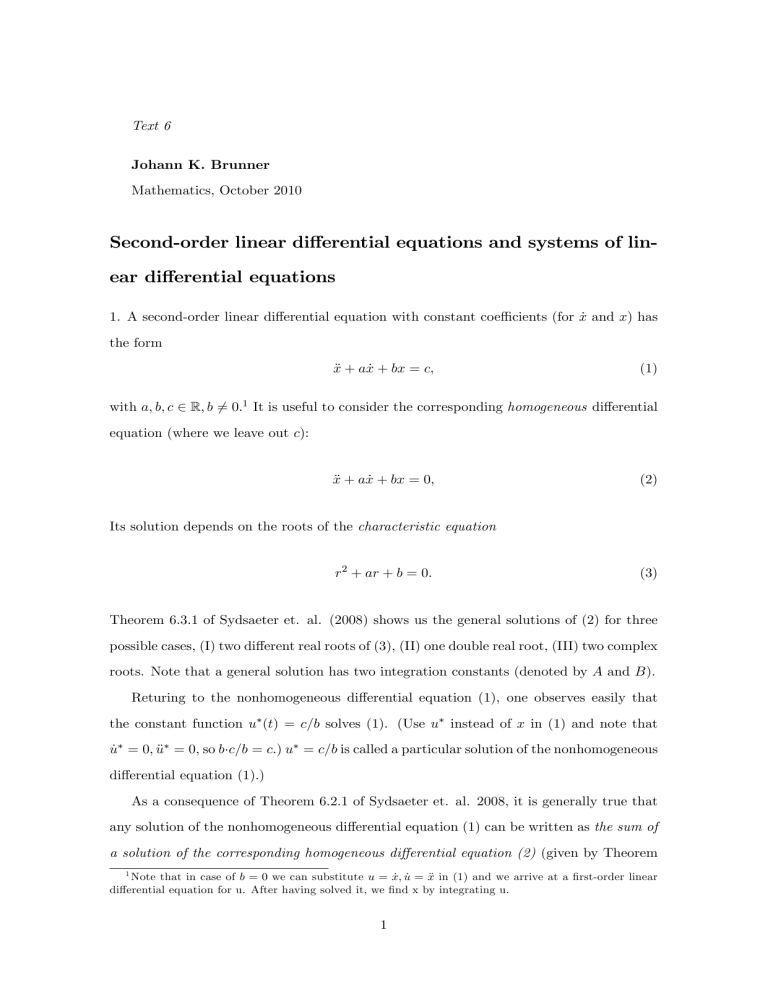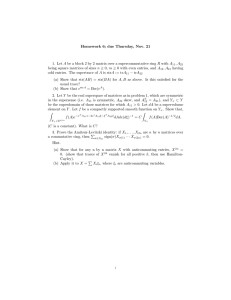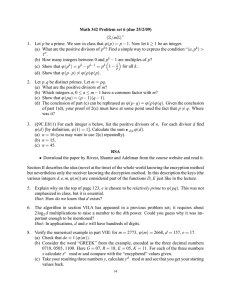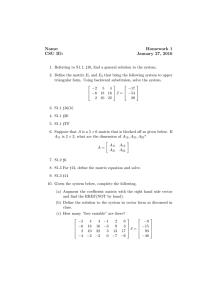Second order linear differential equations and systems of lin ear

Text 6
Johann K. Brunner
Mathematics, October 2010
Second-order linear di¤erential equations and systems of linear di¤erential equations
1. A second-order linear di¤erential equation with constant coe¢ cients (for _ and x ) has the form
• + a x + bx = c; (1) with a; b; c 2 R ; b = 0 :
1
It is useful to consider the corresponding homogeneous di¤erential equation (where we leave out c ) :
• + a x + bx = 0 ; (2)
Its solution depends on the roots of the characteristic equation r
2
+ ar + b = 0 : (3)
Theorem 6.3.1 of Sydsaeter et. al. (2008) shows us the general solutions of (2) for three possible cases, (I) two di¤erent real roots of (3), (II) one double real root, (III) two complex roots. Note that a general solution has two integration constants (denoted by A and B ).
Returing to the nonhomogeneous di¤erential equation (1), one observes easily that the constant function u ( t ) = c=b solves (1). (Use u instead of x in (1) and note that
_ = 0 ; u = 0 ; so b c=b = c: ) u = c=b is called a particular solution of the nonhomogeneous di¤erential equation (1).)
As a consequence of Theorem 6.2.1 of Sydsaeter et. al. 2008, it is generally true that any solution of the nonhomogeneous di¤erential equation (1) can be written as the sum of a solution of the corresponding homogeneous di¤ erential equation (2) (given by Theorem
1 Note that in case of b = 0 we can substitute u = _ _ = • in (1) and we arrive at a …rst-order linear di¤erential equation for u. After having solved it, we …nd x by integrating u.
1
6.3.1) plus a particular solution of the nonhomogeneous di¤ erential equation (1), which is c=b . To …nd precise values for the constants A and B, two conditions, say an initial condition x ( t
0
) = x
0 and a further condition x ( t
1
) = x
1
; must be given.
Clearly, the particular solution u ( t ) = c=b is an equilibrium of the di¤erential equation
(1): if the solution assumes the value c=b from the beginning (that is, the side conditions state x
0
( t
0
) = x
1
( t
1
) = c=b ), it remains there and the di¤erential equation is always ful…lled. We can again ask what happens if we start with a value = c=b (that is, the side conditions specify a path out of equilibrium): if t ! 1 ; will the solution converge to c=b or not? If yes, we call (the equilibrum of) the di¤erential equation globally asymptotically stable . The answer depends on the behaviour of the general solution of the associated homogeneous di¤erential equation (2), whether it goes to zero for t ! 1 (then any solution converges to the particular solution c=b ).
Considering case I of Theorem 6.3.1, it is clear that the function x converges to zero if both roots of the characteristic equation are negative. In case II, the double real root must be negative. In case III, with complex roots i ; its real part must be negative.
We conclude generally that for asymptotic stability the real parts of all eigenvalues must be negative (in case of a real eigenvalue the real part is the eigenvalue).
2. A system of two linear di¤erential equations with constant coe¢ cients is written as:
_ = a
11 x + a
12 y + b
1
; y _ = a
21 x + a
22 y + b
2
;
(4)
(5) or in vector-form, with A as the matrix of the coe¢ cients a ij
: y _
= A x y
+ b
1 b
2
: (6)
An equilibrium of (4), (5) is found by setting _ = 0 ; y _ = 0 ; which means (see (6)) to solve
A x y
= b
1 b
2
: (7)
By Cramer’s rule (chapter 1 of Sydsaeter et. al. 2008), the solution is x = ( a
22 b
1
+
2
a
12 b
2
) = j A j ; y = ( a
11 b
2
+ a
21 b
1
) = j A j :
To see the relation of the system (4), (5) to a second-order linear di¤erential equation, we use (4) to get
1 y = a
12 a
11 a
12 x b
1 a
12
: (8)
Di¤erentiating both sides with respect to t gives
1 y _ = a
12 a
11 a
12
(9)
Using (8) and (9) in (5) gives us
1 a
12 a
11 a
12
_ = a
21 x + a
22 a
12 a
22 a
11 x a
12 a
22 b
1 a
12
+ b
2 or
• ( a
11
+ a
22 x + ( a
11 a
22 a
21 a
12
) x = a
22 b
1
+ a
12 b
2
: (10)
So we are back to a second-order linear di¤erential equation (1) with constant coe¢ cients a = ( a
11
+ a
22
) = tr ( A ) ; b = a
11 a
22 a
21 a
12
= j A j ; c = a
22 b
1
+ a
12 b
2
:
Observe …rst that its equilibrium c=b = ( a
22 b
1
+ a
12 b
2
) = j A j is indeed the same as we found above for x as the equilibrium of the system of two equations (4) and (5).
Next, we have to consider the corresponding homogeneous equation
• ( a
11
+ a
22
) x + ( a
11 a
22 a
12 a
21
) = 0 with characteristic equation r
2
( a
11
+ a
22
) r + ( a
11 a
22 a
12 a
21
) = 0 : (11)
Inspection shows immediately that this is just the characteristic equation of the matrix A
(see chapter 1 of Sydsaeter et.al. 2008). Hence the roots of (11) are the eigenvalues of A .
We know from above that (10) is globally asymptotically stable, if the roots of (11), i.e. the eigenvalues of A are negative (or, if complex numbers, have negative real parts).
3
One can show that this is equivalent to the two properties: tr ( A ) < 0 ; j A j > 0 :
2
Note …nally, that an alternative procedure is to use (5) to …nd an expression for x , di¤erentiate and substitute in (4) to get the second-order di¤erential equation in y :
• ( a
11
+ a
22
) _ + ( a
11 a
22 a
12 a
21
) y = a
11 b
2
+ a
21 b
1
; whose equilibrium ( a
11 b
2
+ a
21 b
1
) = j A j is the same as found for y from (7) above.
Moreover, by comparison one observes that the characteristic equation of this secondorder di¤erential equation is the same as (11) above. Thus, the conditions for stability tr ( A ) < 0 ; j A j > 0 - are the same.
2
Remember that tr ( A ) is the sum of the two eigenvalues, while j A j is their product.
4






